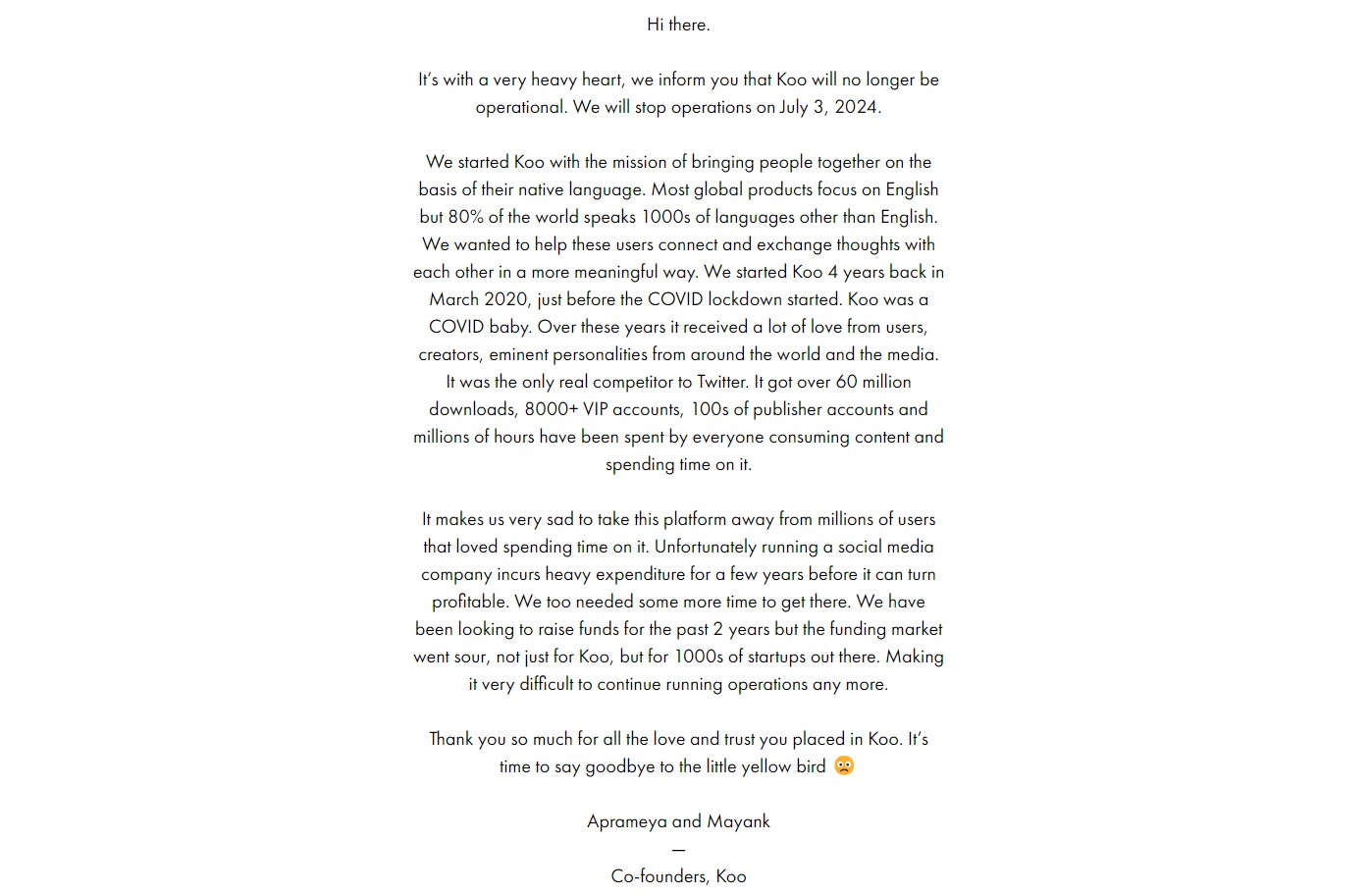The Rise and Fall of Indian Twitter rival KOO: Understanding the Factors Behind Its Shutdown
Table of Contents
- Introduction
- Overview of KOO: From promising start to eventual closure
- Technological Hurdles
- Scalability Problems
- Security Breaches
- Lack of Advanced Features
- Competitive Pressures
- Dominance of Established Platforms
- Competition from Local Rivals
- Regulatory Challenges
- Compliance with Local Laws
- Content Moderation Issues
- Internal Management Problems
- Leadership Disputes
- Financial Instability
- Talent Retention Challenges
- External Factors
- Political Environment
- Impact of the COVID-19 Pandemic
- Conclusion
- Summary of factors contributing to KOO’s shutdown
1. Introduction
KOO, an Indian microblogging platform once touted as a rival to Twitter, eventually faced closure despite its initial success and growing user base. Several factors contributed to this outcome, including technological hurdles, competition, regulatory challenges, and internal management issues. Below is a detailed exploration of the reasons behind KOO’s shutdown.

Koo Co-founder’s Last Message
2. Technological Hurdles
- Scalability Problems: KOO struggled with scaling its operations to accommodate a rapidly growing user base. Frequent downtimes and performance issues frustrated users, highlighting the platform’s lack of robust infrastructure compared to established players like Twitter.
- Security Breaches: The platform experienced multiple security breaches that compromised user data. These incidents undermined user trust and exposed KOO’s inadequate cybersecurity measures, leaving it vulnerable to attacks.
- Lack of Advanced Features: KOO failed to offer features that matched those of its competitors. Essential functionalities such as direct messaging, advanced search capabilities, and multimedia support were either missing or poorly implemented, which contributed to user dissatisfaction.

Koo Co-founder Aprameya Radhakrishna with Rajeev Chandra Shekhar at Delhi, Source : X/apramiya
3. Competitive Pressures
- Market Dominance by Established Platforms: Major social media platforms like Twitter and Facebook continued to dominate the market. Despite initial interest, KOO could not sustain its growth against these giants, which boasted extensive user bases and advanced features.
- Competition from Local Rivals: In addition to global competitors, KOO faced stiff competition from other Indian social media platforms like ShareChat and Moj. These platforms offered more localized content and better user engagement, drawing users away from KOO.
4. Regulatory Challenges
- Compliance with Local Laws: The Indian government imposed strict regulations on social media platforms, requiring adherence to local laws, data localization, and content moderation guidelines. KOO struggled to comply with these regulations, resulting in legal battles and penalties.
- Content Moderation Issues: KOO was criticized for its inadequate content moderation policies. The platform was accused of allowing the spread of misinformation, hate speech, and other harmful content, attracting regulatory scrutiny and damaging its reputation.

Koo co-founder Mayank Bidawatka with Shree Bhupendra Patel, Source : X/mayankbidawatka
5. Internal Management Problems
- Leadership Disputes: Internal conflicts and strategic disagreements among KOO’s leadership led to a lack of clear vision and direction for the company. This mismanagement hindered the platform’s growth and operational efficiency.
- Financial Instability: Despite initial investments, KOO faced difficulties in securing sustained funding. Investors were skeptical about the platform’s long-term viability due to its technological and regulatory challenges. This financial instability limited KOO’s ability to invest in necessary upgrades and expansion.
- Talent Retention: KOO struggled to retain top talent, experiencing high employee turnover and difficulty attracting skilled professionals in technology and management. This weakened the platform’s capabilities and overall performance.
6. External Factors
- Political Environment: The political environment in India also played a role in KOO’s decline. Perceived as a government-endorsed alternative to Twitter, KOO was seen by some as biased, which alienated users who preferred a neutral platform.
- Impact of the COVID-19 Pandemic: While the pandemic initially led to a surge in online activity, economic uncertainties eventually affected advertising revenues. Like many companies, KOO faced financial pressures during this period, exacerbating its existing challenges.
7. Conclusion
KOO’s shutdown resulted from a combination of internal weaknesses and external pressures. Technological shortcomings, intense competition, regulatory hurdles, and internal management issues all contributed to its decline. Despite its potential and early enthusiasm, KOO failed to establish itself as a sustainable and reliable platform in the long run. Its story underscores the complexities of the social media landscape and the necessity of robust infrastructure, effective management, and regulatory compliance for success.
You might like our newly introduced Web stories section-





Very sad to see such a big start up shutting down its business. Very nicely written article
Yes its sad to see them go, thanks for appreciating our work, you can also check out our newly introduced Web Stories section under Story Archives, thanks again for visiting.
Happy reading